A few weeks ago i was at the LABoral Art and Industrial Creation Centre in Gijón to visit Datascape, a new exhibition which looks at the way the constant stream of data now available at the touch of a screen or keyboard is adding new layers to the physical world and is reshaping our perception and interpretation of it. In fact, whether we fully realize it or not, this ever flowing information becomes an integral part of our experience of the world.
The artists who participate in this exhibition follow into the steps of painters who have dedicated their art to depicting our environment but they also reflect upon the complex overlay of information that enables us to live seamlessly in the physical dimension as well as the virtual dimension. The result is ‘datascape’, a new landscape where invisible information augments and enhances the physical world.
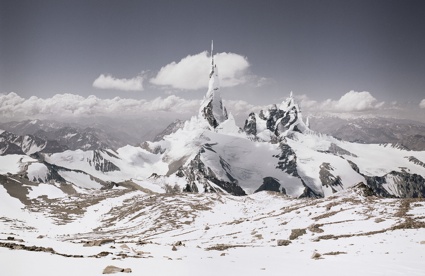 Michael Najjar, High Altitude
Michael Najjar, High Altitude
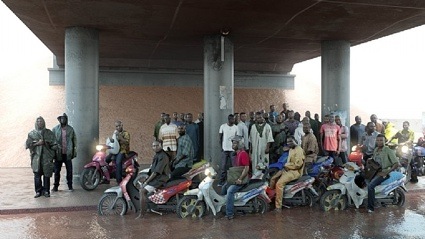 David Claerbout, Oil workers (from the Shell company of Nigeria) returning home from work, caught in torrential rain, 2013
David Claerbout, Oil workers (from the Shell company of Nigeria) returning home from work, caught in torrential rain, 2013
David Claerbout’s work is worth the trip itself. Both the image and the title of Oil workers (from the Shell company of Nigeria) returning home from work, caught in torrential rain, come from a JPEG image found in an online news story. Through 3D computer techniques and a simple camera movement, the photo gets slowly animated. While the men have been stopped on their way home by monsoon rains, the water at their feet seems to be endlessly flowing. The dirty liquid symbolizes both the water we never tend to associate with Africa and the oil industry which activity isn’t to be stopped neither by human rights nor by ecological concerns.
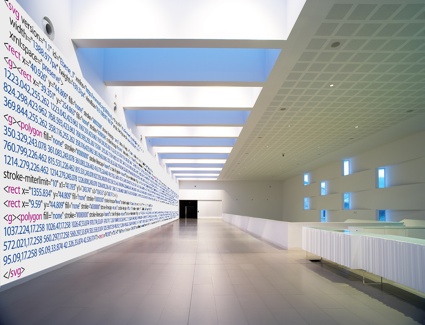 Karin Sander, XML-SVG Code / Source code of the exhibition wall, 2014.
Karin Sander, XML-SVG Code / Source code of the exhibition wall, 2014.
With Source Code, Karin Sander, demonstrates rather elegantly the opacity lingering behind digital technologies. She covered a wall of the exhibition space with its own source code. Look at it and i doubt you can make any sense of it but the small smartphone in your pocket shouldn’t have any problem translating the arrays of characters back into the image of that same wall. The work reminds us that every single object, whether it is a 2D or a 3D one, we see onto our computer screen and take for granted hides a source code. In this work, the source code escapes the virtual and becomes a fresco, a decoration for a physical space.
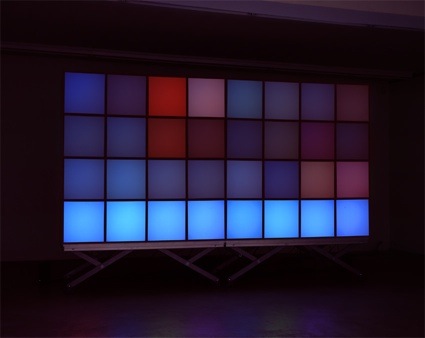 Angela Bulloch, Antimatter³ In the Negative Zone, 2003
Angela Bulloch, Antimatter³ In the Negative Zone, 2003
Angela Bulloch uses 50 by 50 cm ‘pixels’ to create mesmerizing sculptural screens displaying abstract light composition. Each pixel box houses luminous tubes and an electronic control unit. The result is a screen that plays a sequence of Ang Lee’s film The Ice Storm.
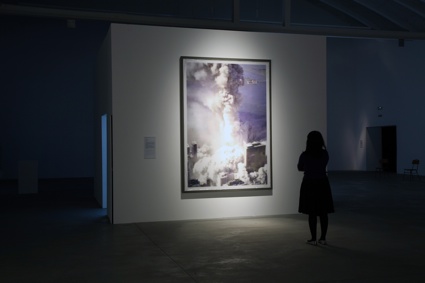 Thomas Ruff, Jpeg NY 15. Photo: LABoral/S. Redruello
Thomas Ruff, Jpeg NY 15. Photo: LABoral/S. Redruello
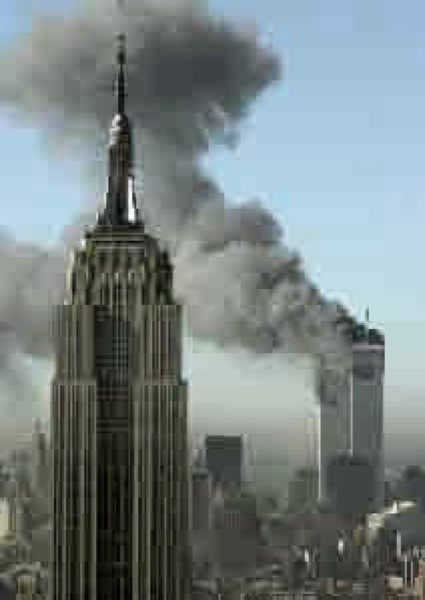 Thomas Ruff, jpeg NY01, 2004
Thomas Ruff, jpeg NY01, 2004
The basis for Thomas Ruff’s monumental Jpegs series are low-res images sourced on the Internet and overblown until they become almost abstract the closer you get to them. The process unsettles the meaning and effect of the photos, whether they reproduce soothing landscapes, porn or tragedies (such as 9/11 attack on New York twin towers) .
The distortion of the image brings, once again, the pixels to the forefront, allowing viewers to disconnect themselves from the subject of the image for a moment and question the reliability of the digital medium to represent reality.
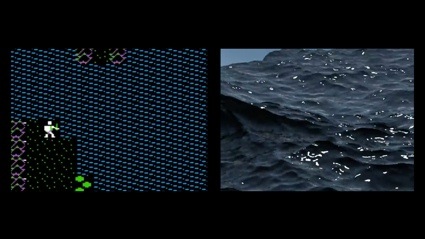 Harun Farocki, Parallel. Photo: LABoral/S. Redruello
Harun Farocki, Parallel. Photo: LABoral/S. Redruello
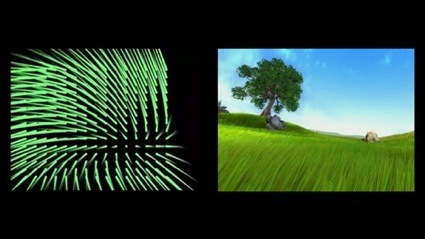 Harun Farocki, Parallel
Harun Farocki, Parallel
Harun Farocki, Parallel (extract)
With Parallel, Farocki brings side by side the history of computer-based animation with elements of art history. The two-channel video installation exposes how the development technology translated into increasingly sophisticated representations of the essential components of a landscape (a tree, the wind, the water, etc.) Details of the landscape that were nothing more than symbolic forms in the early days of computer animation have now reached realistic dimensions, to the point that they are now about to outperform cinematographic and photographic representations. And maybe also reality itself.
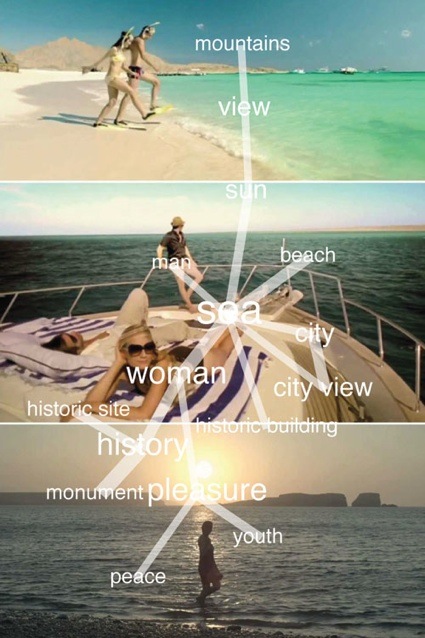 Burak Arikan, Monovacation, 2013
Burak Arikan, Monovacation, 2013
Burak Arikan’s Monovacation highlights the clichés of the tourism industry in all their syruppy glory. The artist compiled official tourism commercials of countries in competition with each other (and in particular with Turkey) and sliced them up into clips lasting no more than 3 to 4 seconds. The segments were then coded with tags. Through a network diagram which runs as a software simulation, these tags are connected to each other via shared clips positioned on a map. A new sequence is then generated transversally in the network map, jumping from one node to the next, following the path of the most central tags. Beaches from Egypt to Portugal, women from Israel to India, mythological figures from Thailand to Turkey, here comes an extracted fantasy of “vacation”…
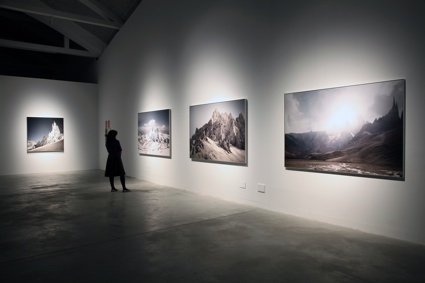 Michael Najjar, High altitude (exhibition view.) Photo: LABoral/S. Redruello
Michael Najjar, High altitude (exhibition view.) Photo: LABoral/S. Redruello
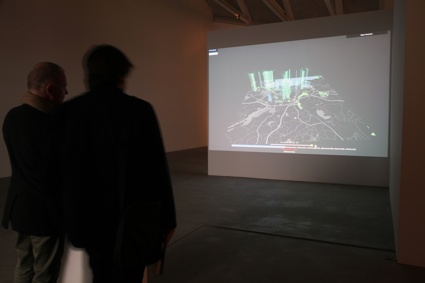 Nerea Calvillo, Polen In the Air. Photo: LABoral/S. Redruello
Nerea Calvillo, Polen In the Air. Photo: LABoral/S. Redruello
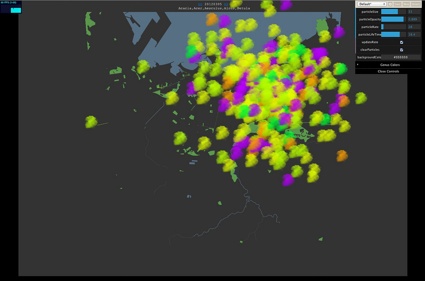 Nerea Calvillo, Pollen in the air
Nerea Calvillo, Pollen in the air
With Pollen in the air, Nerea Calvillo visualizes invisible elements of the landscapes that affect us. The artist mapped clouds of pollen suspended over the streets of Gijón. Pollen in the Air can act as a tool for public information for people with asthma, but also as a way of navigating the city through the rhythms of its vegetation.
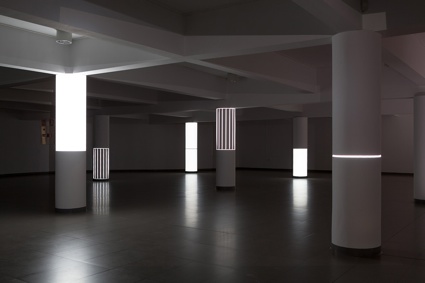 Pablo Valbuena, para-site [6 columns]
Pablo Valbuena, para-site [6 columns]
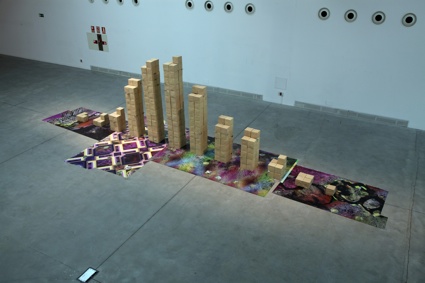 Enrique Radigales. Primer diagnóstico taxonomico. Photo: LABoral/S. Redruello
Enrique Radigales. Primer diagnóstico taxonomico. Photo: LABoral/S. Redruello
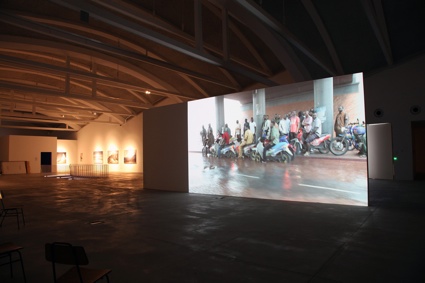 David Claerbout, Oil workers (from the Shell company of Nigeria) returning home from work, caught in torrential rain, 2013. Photo: LABoral/S. Redruello
David Claerbout, Oil workers (from the Shell company of Nigeria) returning home from work, caught in torrential rain, 2013. Photo: LABoral/S. Redruello
Datascape was curated by Benjamin Weil. It remains open at LABoral Centro de Arte y Creación Industrial (Art and Industrial Creation Centre) until 21 September 2014.
